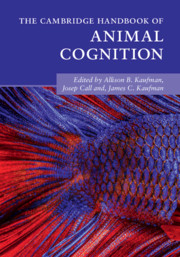Book contents
- The Cambridge Handbook of Animal Cognition
- The Cambridge Handbook of Animal Cognition
- Copyright page
- Dedication
- Contents
- Figures, Tables, and Boxes
- Contributors
- Acknowledgments
- Introduction
- Part I Communication and Language
- 1 Animal Communication Overview
- 2 Communication in Ant Societies
- 3 Symbolic Communication in the Grey Parrot
- 4 Communication in Dogs and Wolves
- 5 Semantic Communication in Primates
- Part II Memory and Recall
- Part III Social Cognition
- Part IV Social Learning and Teaching
- Part V Numerical and Quantitative Abilities
- Part VI Innovation and Problem-Solving
- Index
- References
2 - Communication in Ant Societies
from Part I - Communication and Language
Published online by Cambridge University Press: 01 July 2021
- The Cambridge Handbook of Animal Cognition
- The Cambridge Handbook of Animal Cognition
- Copyright page
- Dedication
- Contents
- Figures, Tables, and Boxes
- Contributors
- Acknowledgments
- Introduction
- Part I Communication and Language
- 1 Animal Communication Overview
- 2 Communication in Ant Societies
- 3 Symbolic Communication in the Grey Parrot
- 4 Communication in Dogs and Wolves
- 5 Semantic Communication in Primates
- Part II Memory and Recall
- Part III Social Cognition
- Part IV Social Learning and Teaching
- Part V Numerical and Quantitative Abilities
- Part VI Innovation and Problem-Solving
- Index
- References
Summary
Ants appeared in the Jurassic and diversified into a multitude of new forms during the Cretaceous, around 100 million years ago. Today, ants are ecologically dominant in most terrestrial ecosystems. In tropical rain forest, ant biomass is four times greater than the biomass of all the vertebrates. The trait common to all ant species is sociality: they are all social insects that live in colonies. As in human societies, the size of ant societies varies enormously, from just a few individuals to tens of millions. Ants show extraordinary adaptations. They evolved the ability to build complex nest structures; they cultivate fungi for food and milk aphids, thus practicing agriculture and animal farming; they have nurseries and cemeteries, they cooperate. The key to their evolutionary success is efficient division labour in which the colony behaves as an organism. To achieve this remarkable social organization, ants rely on effective communication. Even though they use several different channels, such as the visual, acoustic and tactile, chemical communication is the most widespread way to exchange messages in an ant colony. Ants have developed multicomponent body odours, a myriad of exocrine glands and refined chemosensory abilities.
Keywords
- Type
- Chapter
- Information
- The Cambridge Handbook of Animal Cognition , pp. 36 - 55Publisher: Cambridge University PressPrint publication year: 2021
References
- 1
- Cited by



